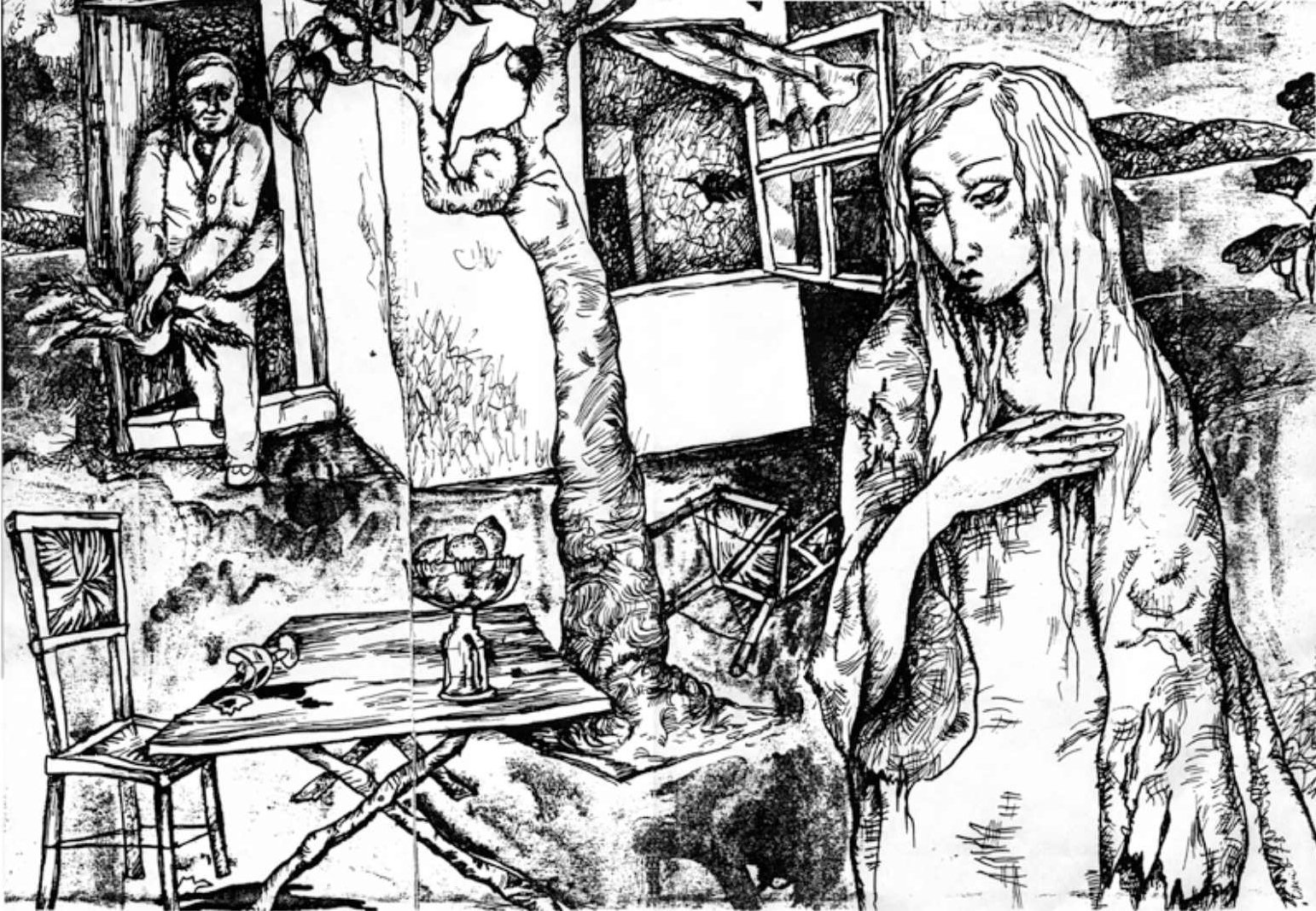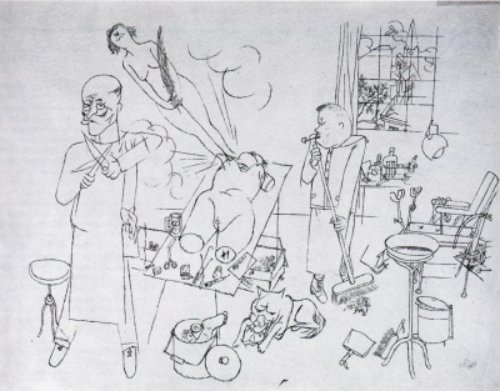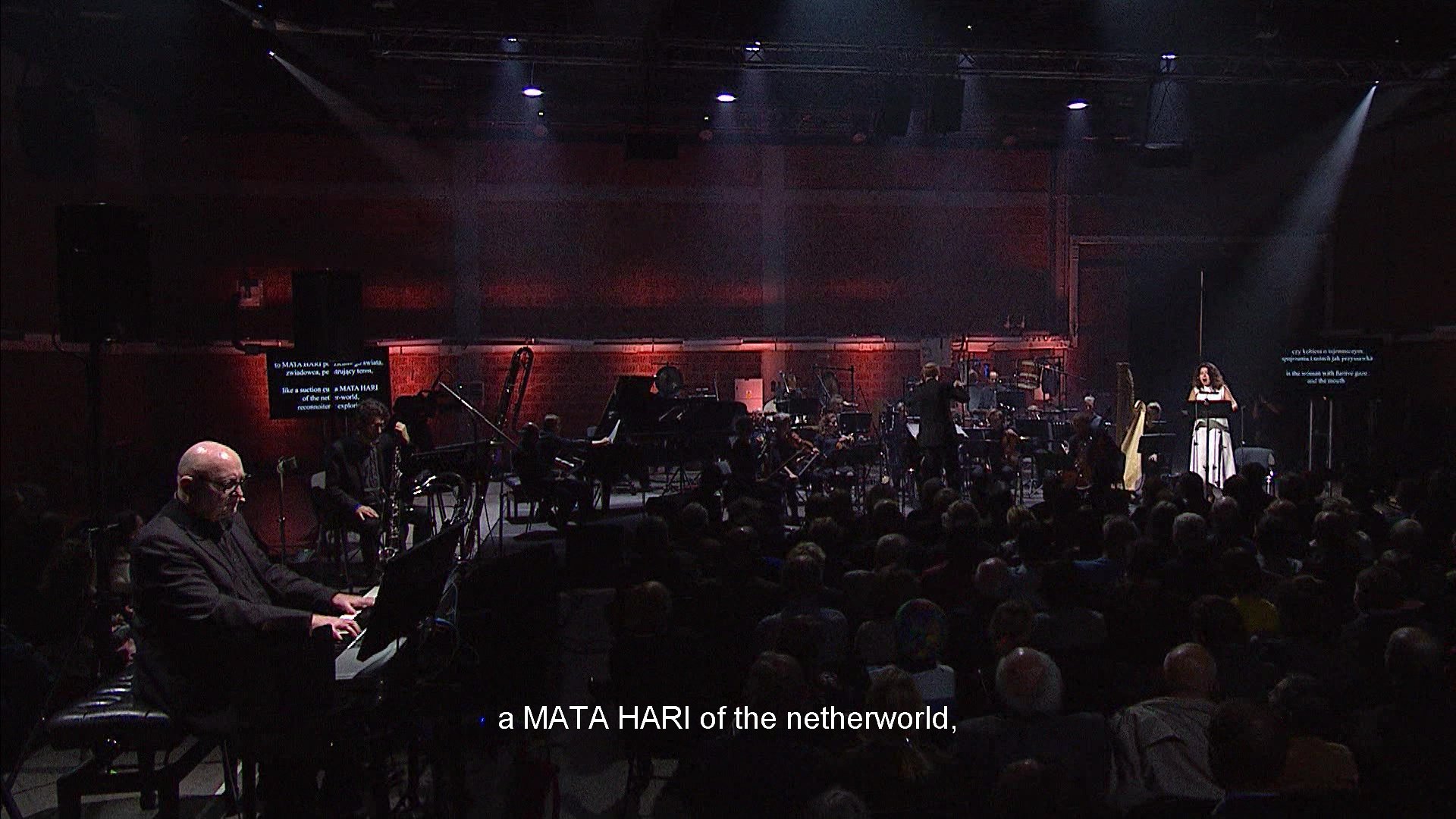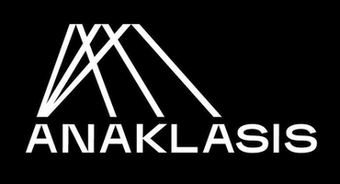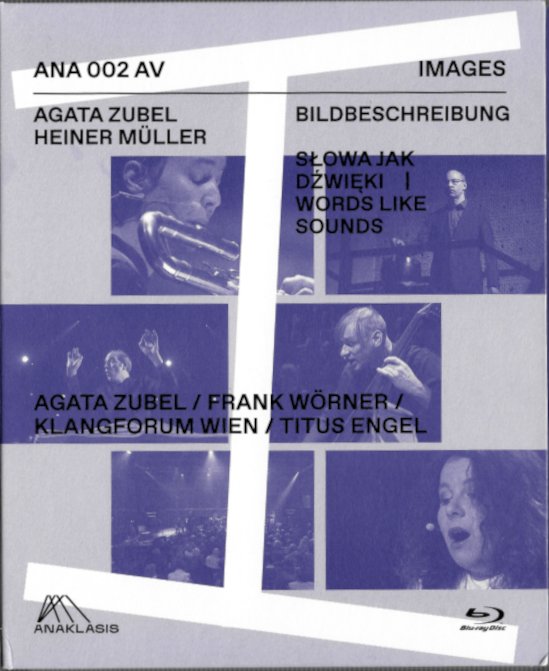
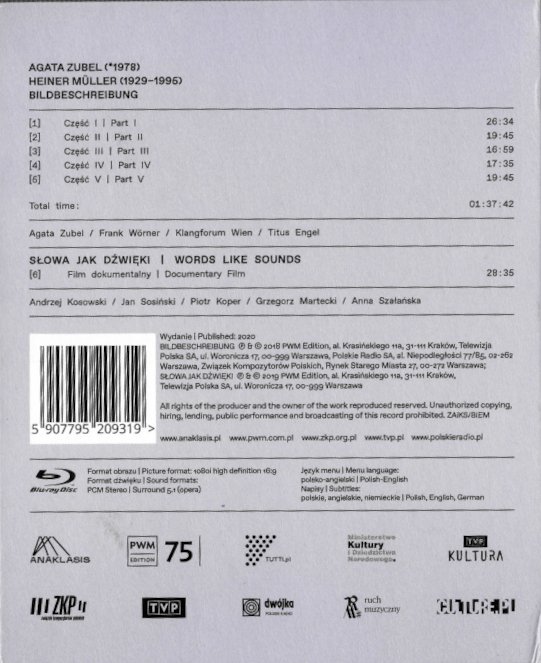
Bildbeschreibung (Description of a Picture) concert for 2 voices, chamber orchestra, special instruments, and electronics. This is the Polish premiere performed on September 27, 2018 of music composed by the Polish Agata Zubel to lyrics by the German playwright Heiner Müller. Titus Engel conducts the Klangforum Wien chamber orchestra at the ATM studio in Warsaw as part of the Warsaw Autumn Festival. "She" sung by soprano Agata Zubel; "He" sung by bariton Frank Wörner. Special instrumental solos (all electrified) are: Vera Fischer on bass flute; Eva Furrer on contrabass flute; Olivier Vivarès on contrabass clarinet; Gerald Preinfalk on tubax saxophone; Andres Nyqvist on double-bell trumpet; Florian Müller on sound-sampling keyboard; Bendikt Leitner on cello; and Alexander Gabryś on doublebass. All special instrumentalist soloists also contribute voiced text. Lyrics in German. Directed for TV by Jacek Dybowtki. Disc also has a bonus extra about Agata Zubel called called Words like Sounds. Subtitles in Polish, German, and English. Released 2022 by Anaklasis Recodings, a division of PWM Edition. Disc has 5.1 sound. Grade: A+ with ‽ and 💓 designations.
This will be a long review for 3 reasons:
To better enjoy this music, it helps to have background information.
The performance itself is extremely original, as my screenshots will demonstrate.
This is the first fine-art Blu-ray recording I’ve seen that was performed for video, recorded, and published by forces not located in Western Europe or Japan. This is a Polish title. That in itself is a milestone for those of us who love classical Blu-rays and hope one day to enjoy these titles from all over the world.
Background
“Bildbescreibung” just means “description of a picture.” But it refers to a specific picture, shown below, created by one Emilia Kolewa, a Bulgarian student of stage design. It seems this picture has no title:
This is a complex but also rather crude image. I think the student artist was familiar with German expressionist artwork from the Blue Rider period. Compare our Bild for example, to Max Beckman’s Tall Man next below:
And two drawings from George Grosz:
Emilia’s student art came to the attention of the East German playwright Heiner Müller. At first Heiner thought he saw errors and mistakes in Emilia’s work. But how can there be a “mistake” in expressionist art? Eventually Heiner began to see alternate visions of reality in the picture. And so, being one of the leaders of “postdramatic theater” in the western world, Heiner published in 1984 a long poem about these alternate visions. He called the poem Bildbeschreibung. Thanks to the multitude of (incompatible) ideas expressed by Heiner in the poem and his gift for spectacular poetic imagery, Bildbeschreibung was immediately taken up by directors all over Europe in a wide variety of stage expressions. I wonder: did starving-student Emilia get any royalties?
The Bildbeschreibung text seems nonsense to me unless you have Emilia’s picture as a starting point. But here’s an odd additional impediment: the picture shown above (the only image I found after looking a lot on the Internet) seems to be missing the top 1/4 or 1/3 of the original work. The poem describes in detail the following parts of the picture that are missing: clouds, sky, the roof of the house, the top of a tree partially obscuring the roof, and most important: an evil-looking bird (a vulture, or a pea-cock, or a vulture with the head of a pea-cock) in the tree looking down on the woman below. This bird is important throughout this libretto, but somebody cropped him out! Please, if anybody knows what the full picture looked like, please let me know!
Heiner’s poem is quite challenging to read and understand. I’m guessing it’s still under copyright, and I never found it on the Internet. But it is printed up in the keepcase booklet, and every word seems to be recited in the performance on the disc. The poem is divided into 5 parts. I’ve attached to this review a summary of what happens in the 5 parts.
DON’T GIVE UP ON THIS BORING REVIEW! It’s going to get better. Let’s move on to composer Agata Zubel, seen next below. She can look tough:
But she’s really sweet. She likes her job because she’s not required to do anything, but she may do what ever she likes. She is not a serialist like Glass, Reich, or Adams droning on endlessly with various angels moaning in solfège syllables until moss starts to grow on your speaker cones. She is more interested in the slippage of tectonic plates under the infinite ocean resulting in an underwater volcano barfing out trillions of cubic miles of magna into the burning atmosphere—that sort of thing. That’s why the Klangforum commissioned her to write Bildbeschreibung for them.
Did the Klangforum members (it’s a coop) know Agata would require all the soloists to recite poetry while playing some of the hardest music they ever saw? She coached the soloists individually . . .
What Agata wants, Agata gets:
The Performance
The venue was a modern sound studio in Warsaw loaded with support for any conceivable electrical device. Folding chairs seated maybe 350 guests. Surrounding the guests were 8 independent island stations for 8 featured soloists. Below we will start at the right rear station and work forward to the main stage and then back to the left rear station. The concert opens with Vera Fischer reciting and playing on bass flute. (In the background a percussionist issues a mysterious low droning tone to tie the soloists together.) Vera plays first on the flute and then gasps for air to recite:
At the next station is Andres Nyqvist on double-bell trumpet. He is able to make various tones with his mutes.
Next up is Alexander Gabryś on doublebass. He recites while playing. Together with Agata he has invented every possible sound made by bowing, plucking, stroking, and hitting on every part of the big violin. His frantic exertions are almost frightening. There must have been a medics standing by:
And next to center stage right is Eva Furrer on contrabass flute:
Stage left is Olivier Vivarès on contrabass clarinet. In this image you see one of several TV displays translating the German text into Polish and English. When not playing as soloist, Vivarès doubles on bass clarinet as part of the orchestra:
Moving now to the rear left, we encounter Florian Müller on keyboard. This keyboard does not make notes like a piano or organ. Each key has been mapped to a recorded sound. A sound could be one of the letters of spoken German, a musical note, or something else like a cough or a snort. Florian is seen constantly engaged in a desperate attempt to get all the sounds requested by his score, but I was rarely able to distinguished exactly what he was contributing to the general mayhem:
Moving further to the rear on the left we get to Gerald Preinfalk on tubax saxophone. When he cuts loose, I found myself jumping up from by home theater seat cheering him on like I was at a professional wrestling match. Alarmed, my wife burst in to see if all was well:
And on the cello, Benedikt Leitner is another performer who gets little or no rest while speaking and playing simultaneously. By the end, bow strings were flying everywhere:
All the soloists are heard by the audience from the side or rear. In front of the audience is the main Klangforum band with the usual instruments for a chamber orchestra plus an accordion, harp, and an enormous array of percussion including double wind machines. Below on the left in the spotlight is Frank Wörner singing the part of He. Agata is on the right in the white dress waiting for more lines for She:
Titus Engel is well-known conductor of contemporary music. It seems he got everyone through this extremely complicated piece without a hitch:
The strings were challenged by various strange and unfamiliar requirements:
There was normal music for the grand piano as well as “prepared” stunts:
All the musicians produce a huge variety of sounds. This is most evident with the percussionists, who seem to have every noisemaker (other than whistles) known to professional music plus many “found instruments” discovered by the composer:
The only instrument in this show that I can play is that ripping sound you get while putting plastic tape on a shipping box:
Heiner includes in his libretto some thrills for lovers of true-crime stories:
And here’s a close-up of Frank Wörner
But most of the poetry is more elevated to appeal to those postdramatic, existentialist navel gazers who contemplate the mysteries of the boundless universe with its collision of galaxies creating heavy metals (gold, lead, uranium) with which to carry on the “insemination of the star by its own dead.” Yes, there is an idea here everyone who has ideas:
The shot below gives you some idea of what Agata’s score looks like and also how you keep the musicians together when they are scattered about the room:
And here is a shot of 7 of the 8 soloists, the audience, and the workstation for the engineers trying desperately to get all this recorded. It’s amazing how well they succeeded.
Agata’s music is endlessly creative, energetic, and dramatic. Agata calls this an opera. But I think it really post-dramatic theater in concert form. Wikipedia states that postdramatic theater “is not primarily focused on the drama in itself, but evolves a performative aesthetic in which the text of the performance is put in a special relation to the material situation of the performance and the stage.”
What the heck does that mean? Well, we have many postdramatic performances featured on this website! The best example would be our 5 complete reviews of stagings by Robert Wilson. See, for example, our review of Adam’s Passion, where Wilson puts his musicians performing Pärt behind the audience in a special venue (an abandoned factory that once made submarines). The big differences between Adam’s Passion and Bildbeschreibung are (1) Wilson focuses on staging and Agata focuses on poetry and (2) Pärt lulls you to sleep and Agata wakes you up. Other alleged postdramatic artists featured on this website are Pina Bausch (Orpheus and Eurydike) and Robert Lepage (the Met Wagner Ring Box).
Product of Poland
When I started this website in 2007, I though we would soon be getting Blu-rays from many countries. Didn’t happen. Almost everything comes from Western Europe. (NHK in Japan contributed about a dozen wonderful symphony titles and then went dormant). Making Blu-rays is hard, but figuring out how to sell them is even harder.
During the month I was born, Hitler started the Second World War and Poland was divided between Germany and Russia. Poland was suppressed ruthlessly and dominated by outsiders until 1989 (founding of the Third Republic of Poland). Since then I have from time to time become aware that Poland has been on the rise. And recently a reader tipped me off: a company called PWM Edition in Krakow is now making Blu-rays under the Anaklasis brand! Hurrah for Poland!
Time to sum up. Here we have a piece based on a weird but compelling drawing and a weird but compelling poem. The astonishing music is intriguing with a huge range of instruments and techniques. The video print is not the sharpest ever, but fine considering the dark venue with performers located throughout the hall. Video content pace is very fast, but this is justified because it’s so much fun to see how the musicians make all those wild sounds.
The stereo sound is fine. The surround sound is yet a huge notch better. Come to think of it, this is the only concert I know of where the sound consistently comes at the audience from all directions—so surround sound is a must! The detailed keepcase booklet was written with loving care, and the bonus extra is informative. And even the Blu-ray disc itself is different: it’s partly transparent and partly translucent! Congratulations to Agata Zubel and all the others who worked in this A+ title. I’m giving this the 💓 because I think it’s the best piece of contemporary concert music we have now in Blu-ray and I think it’s really fun to watch.
To purchase, please see options available through the Anaklasis website below. It seems now that they are set up to ship to Europe but maybe not to the United States. If you have any particular interest in contemporary music, you have to get this somehow! This premiere in Poland will be hard to reproduce. It has a shot at making Agata into a legend in the future (like the original Einstein on the Beach made Glass famous worldwide). And the Anaklasis disc could quickly become a collectors item.
Here’s my outline with an overview of the 5 Parts of Bildbeschreibung:
Part 1. The Picture. An overview of the main elements of the picture drawn by Emilia Kolewa. There is general disarray, and a storm seems to be coming out of the house.
Part 2. “She” dominates the picture. She seems to be a wounded victim. Who hurt She? A menacing “He” is coming out of the house. Is this a flashback suggesting that He has abused She? (Sorry for the bad grammar.)
Part 3. The gruesome passion killing of She. But wait! Maybe She is not a victim, but a thirsty angel from the underworld!
Part 4. She is revealed as a spy (MATA HARI) come to usher in the Grand Maneuver— the endless convulsions of death and resurrection underlying the firmament—the “insemination of the star by its own death.”
Part 5. Or maybe Part 4 is wrong. Maybe this is just a fight among He, She, and The Bird. Maybe the bird saves the woman by dive-bombing the man and blinding him in the frozen storm.
Here this summary sounds like nonsense, but it Heiner knows how to make all this sound important.
